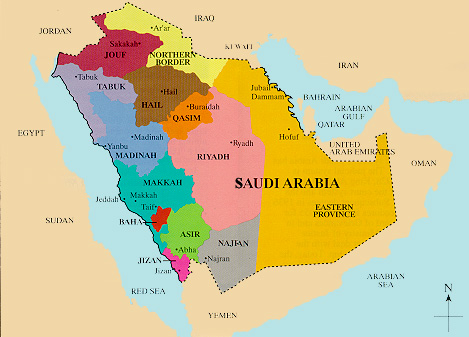For this project, I will be focusing on the third Saudi State. In 1902 Abdul Aziz Ibn Saud captured Riyadh, the Al-Saud dynasty's ancestral capital, from the rival Al-Rashid family. Abdul Aziz continued the fight conquering more territory, including the Hijaz, includes Medina and Mecca, between 1913 and 1926. On January 8, 1926 Abdul Aziz Ibn Saud became the King of Hijaz. On January 29, 1927 he took the title King of Nejd. After the Treaty of Jedda was signed on May 20, 1927, the United Kingdom recognized the independence of Abdul Aziz's territory, known as the Kingdom of Hijaz and Nejd.4 In 1932, these regions were unified as the Kingdom of Saudi Arabia. Saudi Arabia is named after the ruling Al Saud family, which came to power in the 18th century. An important region of Saudi Arabia is the Hijaz, the birthplace of the Prophet Muhammad. This, along with Saudi Arabia’s strict interpretation of Sunni Islam known as Wahhabism, has created a theocracy, alongside the monarchy. The ruling lineage continued after the King of Nejd’s death in 1953, as various sons have ruled since.1
The stable dynasty in Saudi Arabia allowed the kings to concentrate on modernization. This allowed Saudi Arabia to develop as a regional power, especially after the discovery of oil in 1938. The country has slowly taken full control over its oil, after early oil production was in the hands of U.S. controlled Aramco (Arabian American Oil Company).1
Saudi Arabia’s ties with the U.S. tightened, after asking the U.S. for help in dealing with the Iraqi invasion of Kuwait in 1990. It welcomed the stationing of U.S. troops in the country and took part in the liberation of Kuwait. The U.S. would keep a military presence in Saudi Arabia until 2003, after the Saudi government refused to let the U.S. use it as a staging ground to invade Iraq.1
After the terrorist attacks on New York and Washington of 11 September 2001 - carried out mainly by Saudi nationals - the Saudi authorities were further torn between their natural instincts to step up internal security and pressure to allow a greater degree of democracy.1
It was discovered that 15 out of the 19 plane hijackers in the September 11, 2001 terrorist attack were Saudi citizens. This tore the Saudi government on whether it should step up security or allow a greater degree of democracy. Since then, demands for political reform have increased, as has the frequency of militant attacks. Many attacks are targeted at westerners, and are suspected of having links with Al-Qaeda. The security forces have made thousands of arrests.1
Municipal elections in 2005 were a first, limited exercise in democracy. But political parties are banned, therefore there can be no opposition to the King or his government.1
1938 - Oil is discovered and production begins under the US-controlled Aramco (Arabian American Oil Company).
1953 November 9: King Abdul Aziz dies. He is succeeded by his son Saud.
1958: Change in the constitutional construction, where the kings absolute power was reduced, and legislative and executive powers were transferred to the prime minister. A couple of months later a cabinet system was introduced.
1960 - Saudi Arabia is a founding member of OPEC (Organization of Petroleum Exporting Countries).
1964: Prince Faisal replaces Saud as king.
1973: Saudi Arabia plays a leading role in a oil boycott against those Western countries that supported Israel in the Yom Kippur War. This resulted in oil prices four times higher than earlier.
1975 March - King Faysal is assassinated by his nephew, Faysal Bin-Musaid Bin-Abd-al-Aziz; he is succeeded by his brother, Khalid Bin-Abd-al-Aziz Al Saud.
1979 - Saudi Arabia severs diplomatic relations with Egypt after it makes peace with Israel.
1980: Saudi Arabia takes full control over Aramco.
1982: King Khalid dies. He is succeeded by Fahd.
1987 - Saudi Arabia resumes diplomatic relations with Egypt, severed since 1979.
1990 - Saudi Arabia condemns Iraq's invasion of Kuwait and asks the US to intervene; it allows foreign troops, the Kuwaiti government and many of its citizens to stay in Saudi Arabia but expels citizens of Yemen and Jordan because of their governments' support of Iraq.
1991 - Saudi Arabia is involved in both air attacks on Iraq and in the land force that went on to liberate Kuwait.
1994 - Islamic dissident Osama Bin Laden is stripped of his Saudi nationality.
1996 June - A bomb explodes at the US military complex near Dhahran killing 19 and wounding over 300.
2001 11 September - 15 of the 19 hijackers involved in attacks on New York and Washington are Saudi nationals.
2001 December - King Fahd calls for the eradication of terrorism, saying it is prohibited by Islam; government takes the unprecedented step of issuing ID cards to women.
2002 November - Saudi foreign minister says his country will not allow the US to use its facilities to attack Iraq, even in a UN-sanctioned strike.
2003 April - US says it will pull out almost all its troops from Saudi Arabia, ending a military presence dating back to the 1991 Gulf war. Both countries stress that they will remain allies.
2003/2004- Series of terrorist attacks across country targeted towards westerners. Al Qaeda main suspect.
2005: King Fahd dies. He is succeeded by Abdullah, formerly Crown Prince.
2005 November - World Trade Organization gives the green light to Saudi Arabia's membership following 12 years of talks.
2007 April - Police say they have arrested 172 terror suspects, some of whom trained as pilots for suicide missions.
2007 October - Royal decree orders an overhaul of the judicial system.
2009- King Abdullah appoints country’s first woman minister.






